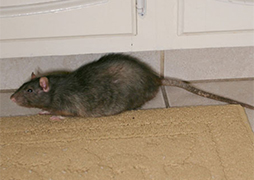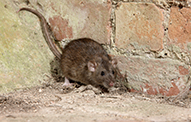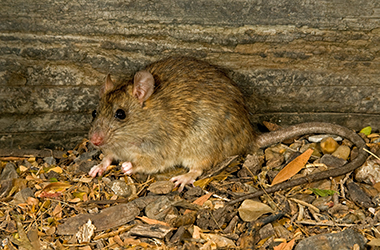
Roof Rat Facts
- Weight: 140 to 280 Grams
- Size: Roof rats are usually about 38 cm long, and have a long hairless tail that can be about 35 cm long
- Color: Light black to grey smooth fur on their bodies with off white to grey underbellies
- Appearance: Appear sleek and graceful with a gray to black smooth coat, large ears/eyes, pointed snout and long hairless tail
Roof Rat Behavior
As their name indicates, roof rats usually nest high above ground in trees, tall overgrown shrubs, or dense vegetation such as ivy. Roof rats are excellent climbers and often access homes by running along tree branches, cables or wires. In buildings, roof rats typically nest in the upper part of structures in enclosed or elevated spaces such as attics, walls, false ceilings, and cabinets. They are very agile and can squeeze through openings only 1.27 cm wide. Roof rats can climb down to a food source.
Roof rats routinely travel up to 100 Meters for food. They often can be seen at night running along overhead utility lines or fence tops. They have an excellent sense of balance and use their long tails to steady themselves while traveling along overhead utility lines. They move faster than Norway rats and are very agile climbers, which enables them to quickly escape predators.
Given their history of causing damage (gnawing through wiring, food contamination, etc.) and health problems (vectors for salmonella, murine typhus, etc.), it is important that homeowners understand how to identify roof rats and businesses understand how to protect themselves from these costly pests.
Habitat/Harborage
- Specializes in climbing
- Can enter structures through trees, power lines
- Dwells in areas off the ground like attics, wall voids, hollow trees, vine-covered fences
Feeding Habits
- Has a preference for the sweetness of fruit
- However, will feed on anything, including pet food
- Needs water everyday
Protection
- Use hardware cloth to seal open vents, especially in crawl spaces, attics, and roofs
- Eliminate waste piles outside of home
- Make sure garbage containers are sealed tightly
- Eliminate potential food sources like left over pet food and grains from bird feeders
- Trim vegetation to prevent from becoming overly dense
- Health Concerns
- How to Get Rid of Rats
- Rat Bites and Treatment




